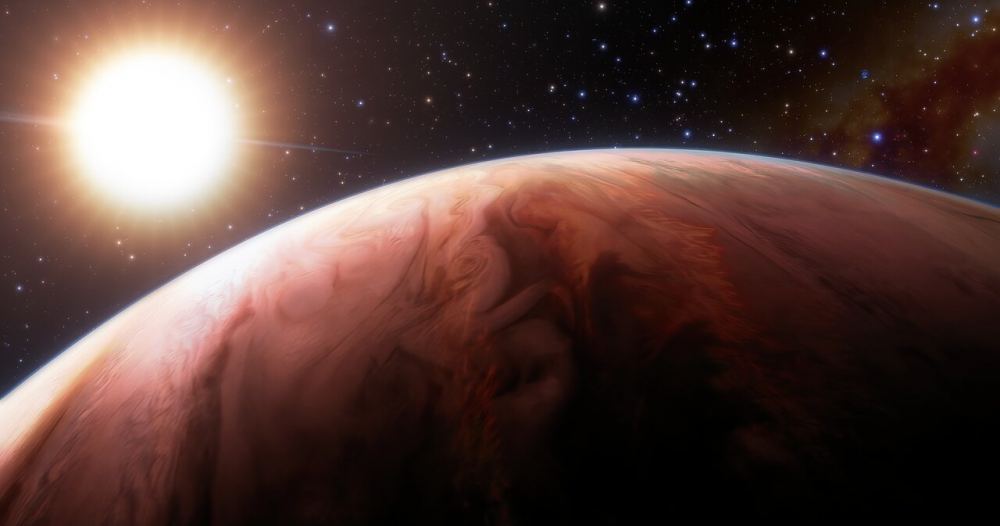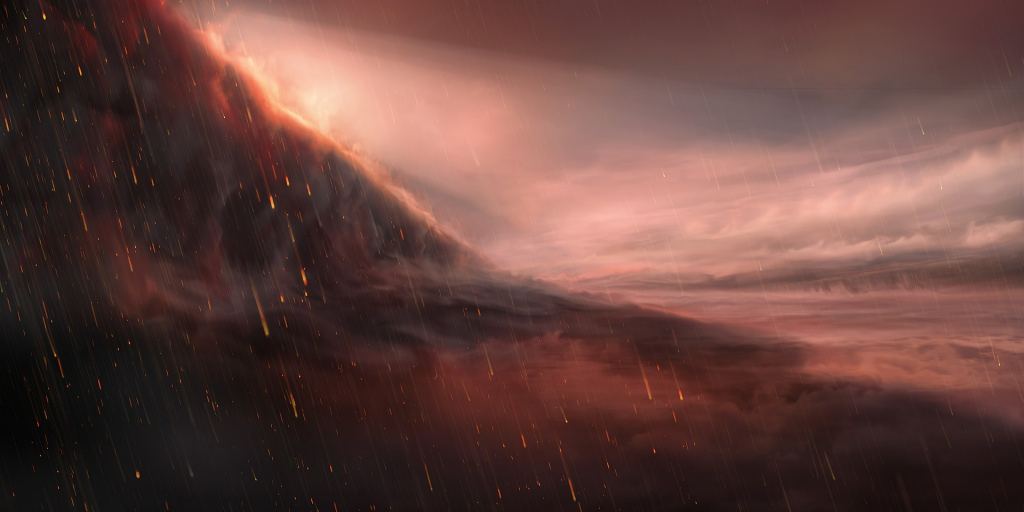In the annals of “strange new worlds”, the ultra-hot Jupiter planet WASP-76b ranks right up there as a very unusual place. There’s no surface, but it does have a massive, hot atmosphere. Temperatures average a raging 2000 C and rise up to 2400 C in one hemisphere. That’s hot enough for mineral and rock-forming elements like calcium, nickel, and magnesium to get vaporized and float around in that thick blanket of air. Not only that, but iron probably rains down through the clouds.

WASP-76b sounds like it could be a twisted science-fictional cross between the Star Warsian planets Bespin and Mostafar, but it’s actually a real place. This world was discovered in 2013, and right away, it caught scientists’ attention. First, it really hugs its parent star, orbiting at a distance of only about 5 million kilometers. That’s about 12 times closer than Mercury is to the Sun. Next, the extreme heat from the star actually puffs the planet up, making it almost twice the radius of Jupiter.
Planetary experts have studied WASP-76b quite a bit over the years. They want to know more about its atmosphere and its formation. Recently, a team led by astronomer Stefan Pelletier watched WASP-76b as it passed in front of its star. They used the MAROON_X high-resolution spectrogram to measure the chemistry of the planet’s atmosphere. They found at least 11 rock-forming elements floating around in the thick blanket of air at this world. These include sodium, potassium, lithium, nickel, manganese, chromium, magnesium, vanadium, barium, calcium, and, as previously detected, iron.

This illustration shows a night-side view of WASP-76b. It has a day side where high temperatures vaporize metals. Strong winds carry iron vapor to the cooler night side where it condenses into iron droplets. Courtesy: ESO/M. Kornmesser.
How Do Rock “Vapors” Happen on a Planet?
Studies of places like WASP-76b give clues to the process of planetary formation. Astronomers think the rocky bodies typically form relatively close to the parent star. Their metallic and rocky materials can withstand heat. The gas- and ice-giant worlds may form relatively close as well. But, eventually, they migrate to places where their volatile elements (hydrogen, etc.) can survive. That’s the way it probably happened in our own Solar System. So, one of the many aims in the search for exoplanets is to figure out if planetary formation happens in roughly the same way around many different stars.
As astronomers began finding more exoplanets, Hot Jupiters showed up first. They’re large and can usually be spotted in the glare of their parent stars. They orbit close to their stars, which heats them up. That’s where the term “hot Jupiter” originates.
In the case of WASP-76b, extreme heat vaporizes metals. Normally, at a rocky world, those metallic elements would solidify into terrain. That’s what happened here on Earth, Mars, Jupiter, and Mercury. But, for this Hot Jupiter, they simply become part of the air.
Interestingly, they also exist in the gas giants of our own Solar System, but those worlds are much colder than WASP-76b. So, the metallic elements are “frozen out” and they don’t show up in the atmospheres of those worlds, according to Pelletier.“Truly rare are the times when an exoplanet hundreds of light-years away can teach us something that would otherwise likely be impossible to know about our own Solar System,” he said. “That is the case with this study.”
Finding A Rarity and What It Means
The element vanadium appears in that list of metallic vapors in WASP-76b’s atmosphere. Finding it just adds to the strangeness of that world. Pelletier points out that was the first time that material had ever been found on an exoplanet. “This molecule is of high interest to astronomers because it can have a great impact on the atmospheric structure of hot giant planets,” he said. “This molecule plays a similar role to ozone being extremely efficient at heating Earth’s upper atmosphere.”
Interestingly, the abundances of these rocky materials closely match their abundance in the Sun and WASP-76 (the host star). That doesn’t mean they both formed from the same cloud since there’s a distance of 634 light-years between the two. Instead, it provides an intriguing clue to astronomers about how gas giants actually form in any given protoplanetary nebula. It may imply that gas-giant planets, like Jupiter and Saturn, coalesce out of the gas and dust of a protoplanetary disk. That’s pretty similar to what a star does as it forms.

Artist’s impression of a gas-giant planet (possibly a “hot Jupiter”) forming in the protoplanetary disk of its host star. [NASA/JPL/Caltech/R. Hurt]
Worlds like Mercury, Venus, and Earth, likely form from the gradual accretion and collisions of dust, rocks, and planetesimals to make rocky planets. The discovery of rocky metallic elements on WASP-76b is another step toward understanding the formation of gaseous planets around distant stars. It should also give some interesting insights into the 𝐛𝐢𝐫𝐭𝐡 and evolutionary processes of Jupiter, Saturn, Uranus, and Neptune.





